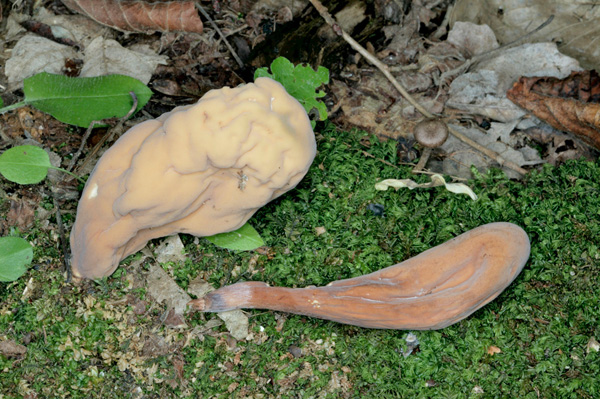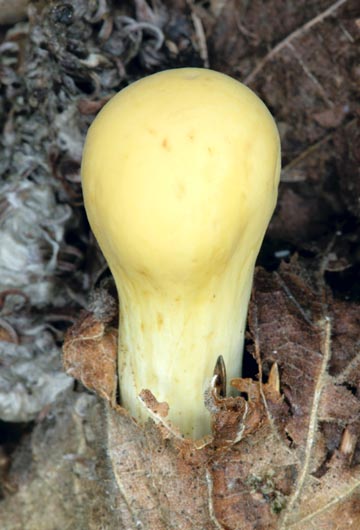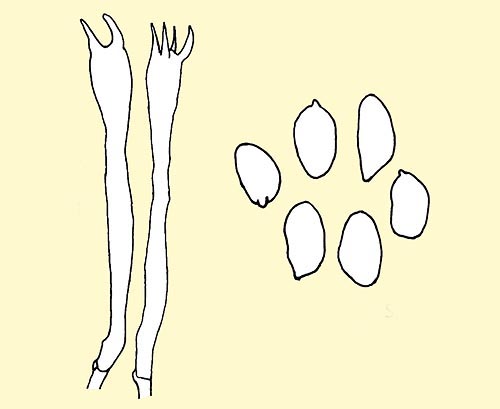
Text © Pierluigi Angeli

English translation by Mario Beltramini

The Clavariadelphus pistillaris recalls a club. Poorly edible © Giuseppe Mazza
Order: Gomphales Jülich 1981.
Family: Gomphaceae Donk 1961.
Genus: Clavariadelphus Donk 1933.
Clavariadelphus pistillaris (L.: Fr.) Donk 1933.
The name comes from the Latin “pistillum” = mortar pestle, due to its typical shape.
Commonly known as mazza d’Ercole, bastone d’Ercole, titina de vaca (Italian); mano de mortero, mano de almirez, porra, bossa, joiki arrunt (Spanish); clavaire en massue, clavaire en pilon (French); Large-clubbed Clavaria (English) and Herkuleskeule (German).
Description of the genus
The genus is characterized by fungi shaped as clubs, mortar, with the top which may be rounded or truncated, robust, hollow when old.
They are fleshy and firm fungi growing as terricolous or humicolous, often in great number, but always single, usually of brown-yellow, ocherous-grey, yellowish colour, tending to the green with the FeSO4.

Ocher-yellow when young © Giuseppe Mazza
The hymenium covers almost all the stem and is sub-smooth or wrinkled; only when ripe it becomes pruinose due to the ripening of the spores.
The flesh is white, ocherous-white, without any particular smell and sour taste.
Description of the species
Carpophore: 7-15 (30) cm high × 2-6 cm broad, typically clavate, from cylindroid to strongly clavate, with rounded or convex apex, at times enlarged in the upper part of the club; finely rugged surface, especially in the upper part where the hymenophore is placed. The colour is ochre-yellow, orange-yellow, spread of violet in the medium-lower part, when ripe it becomes again ochre-yellow due to the ripening of the spores, the basal part from paler to white; due to the handling, when touched it tends to get a violaceous-brown colouration. The base of the carpophore has some white mycelial cords at the base of the stem.
Hymenophore: placed in the upper part of the club, little differentiated, it is finely rugged, pruinose when ripe.
Flesh: initially firm, then soft and spongy but yet compact, white, becomes violaceous brownish when cut, it stains of brownish especially in the lower part, absence of smell, sour tasty.
Chemical reactions: the bright yellow hymenium with SO4H2; the flesh turns to gold yellow with the KOH, to the green grey with the SO4Fe.
Habitat: it grows in summer and in autumn in the latifolious forests especially under the beech; is solitary or gregarious.
Edibility: poorly edible.
Spores: ellipsoidal, elongated, at times rather compressed, guttulate, not amyloid, 10-12 × 7-8 µm.
Basidia: clavate, guttulate, tetrasporic, some also bisporic, with up to 10 µm long sterigmata, with joint buckles, 82,5-122,5 × 10-13,75 µm. Monomitic structure of the carpophore.

Basidia and spores of Clavariadelphus pistillaris © Pierluigi Angeli
Remarks: without any doubt, it is a fungus easy to be determined, at least for what the genus is concerned, due to the typically clavate shape.
For what the species is concerned, its determination is somewhat more difficult if it grows in mixed woods, much easier when found in the pure beech ones.
In the mixed woods it is possible to find the Clavariadelphus pistillaris together with the Clavariadelphus truncatus (Quélet) Donk, which, in its typical form of club truncated at the apex, is easy to determine, but, when young and with a not yet finalized shape, it may be mistaken with the Clavariadelphus pistillaris, also due to the colour, which is the same. In such case, the organoleptic characters will help us.
As a matter of fact, the taste is clearly sweetish in Clavariadelphus truncatus and bitterish in Clavariadelphus pistillaris.
In the ilex woods, therefore in more Mediterranean zones, we get the Clavariadelphus flavoimmaturus Petersen, which might be mistaken with Clavariadelphus pistillaris.
But, besides the different habitat, when young it is lemon yellow, ochre-brownish when adult and its flesh is always sour. Also the spores are slightly narrower.
Synonyms : Clavaria pistillaris L. (1753) (basionym); Clavaria herculeana Lightf. (1789).
→ For general notions about Fungi please click here.
→ To appreciate the biodiversity of MUSHROOMS please click here.
